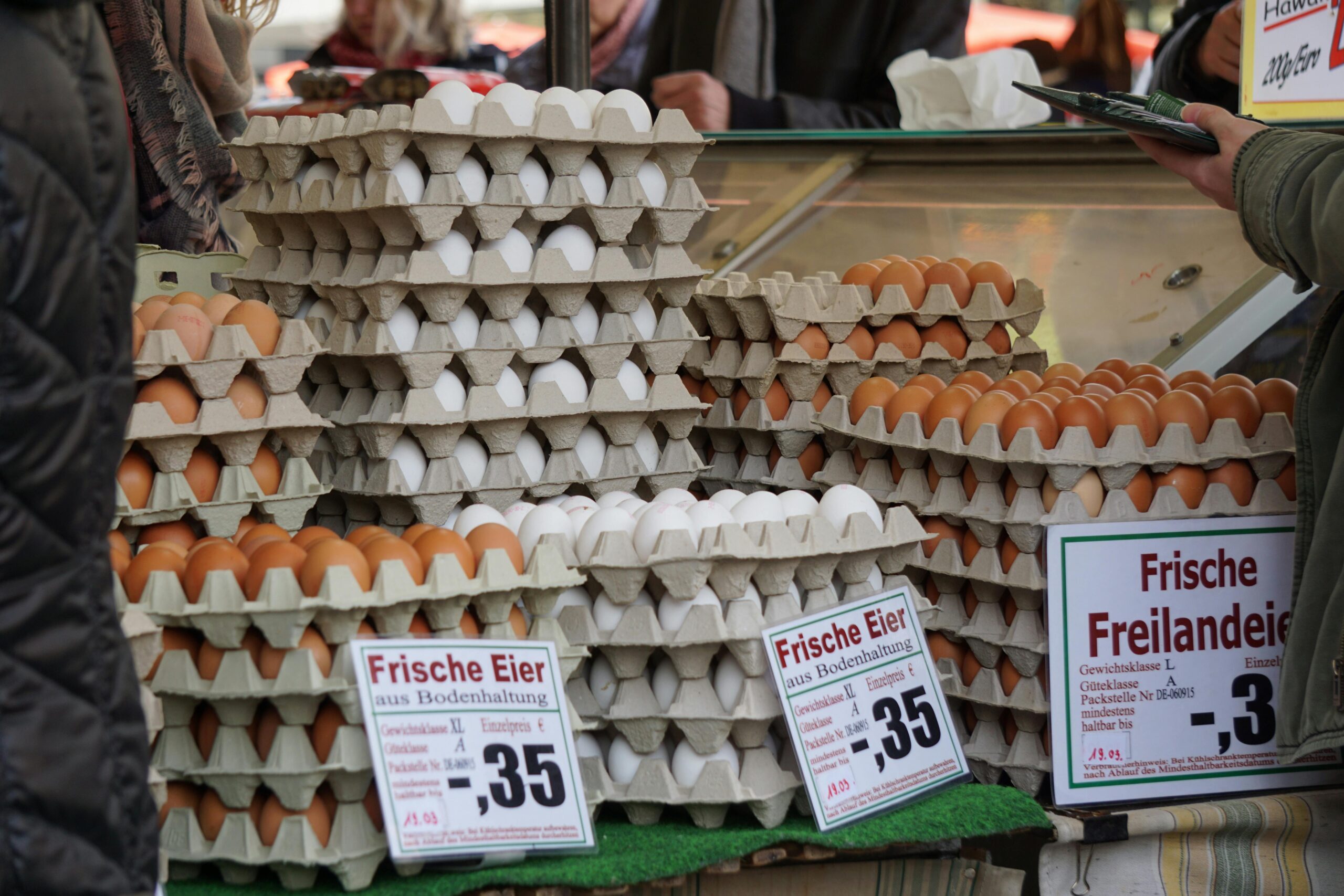Egg Price In Pakistan: Why Are Costs Rising And What To Expect is a hot topic that’s grabbing everyone’s attention these days. If you’ve noticed the egg price in Pakistan going up like never before, you’re not alone. But what’s really causing this sudden surge? Is it just inflation, or are there hidden factors driving up the cost of eggs across the country? In this article, we’ll dive deep into the reasons behind the rising egg prices in Pakistan, explore the current market trends, and discuss what consumers can expect in the coming months. So, if you’re wondering “Why are eggs getting so expensive?” keep reading to find out all the must-know details.
The egg price in Pakistan 2024 has seen a sharp increase due to multiple reasons, including feed shortages, transportation costs, and seasonal demand spikes. Many people are asking, “Will egg prices continue to rise?” The answer isn’t simple, but understanding the supply chain challenges and economic factors can give us some clues. Poultry farmers are struggling with higher costs for feed ingredients like maize and soybean, which directly impacts the cost of eggs in Pakistan. Plus, inflation and currency fluctuations have made imports more expensive, adding extra pressure on prices.
Moreover, the daily egg price in Pakistan varies from region to region, but the overall trend is unmistakable — costs are climbing steadily. Consumers are feeling the pinch as eggs, a staple protein source, become less affordable. Will this trend reverse soon or are we in for more price hikes? Stay tuned as we uncover expert opinions, government policies, and market forecasts related to the egg price hike in Pakistan. Whether you’re a buyer, seller, or just curious about food prices, this guide will help you understand the complex factors behind today’s egg prices.
Top 7 Reasons Behind the Surging Egg Price in Pakistan: What Every Consumer Must Know
Egg price in Pakistan has become a hot topic lately, leaving many consumers worried about their daily budget. The surging cost of eggs is not a simple issue, it involves many factors that have been playing their role quietly over the years. You might have noticed eggs getting expensive at your local market, and wondering why this is happening now? This article will explore the top 7 reasons behind this rise, so every consumer in Karachi and across Pakistan must know what is going on and what to expect in future.
1. Increase in Feed Costs
One of the biggest reasons egg prices in Pakistan are rising is because of the soaring cost of poultry feed. Almost 70% of the cost of producing eggs comes from feed ingredients like maize and soybean. The prices of these raw materials have increased dramatically due to several reasons including bad weather conditions, import restrictions, and global supply chain disruptions. When the farmers have to pay more for feed, naturally, they increase the price of eggs to cover their expenses.
- Maize prices increased by almost 30% in last year
- Soybean imports became costly due to tariff hikes
- Local production of feed ingredients is insufficient to meet demand
2. Impact of Inflation and Currency Devaluation
Pakistan’s economy has been facing inflation and currency depreciation for a while. Inflation increases the costs of transportation, energy, and packaging materials which are all part of egg production chain. The devaluation of Pakistani Rupee makes it expensive to import machinery, medicines, and sometimes feed ingredients. Together, these factors force poultry farmers to raise their egg prices to maintain profitability.
3. Diseases and Health Issues in Poultry Farms
Poultry farms in Pakistan are often vulnerable to diseases such as Avian Influenza and Newcastle Disease. Outbreaks of such diseases reduce the number of laying hens and disrupt production cycles. When supply decreases but demand remains the same or increases, prices naturally go up. Also, farmers spend more money on vaccines and medicines to protect their flocks, which adds to their costs.
4. Seasonal Demand Fluctuations
Egg prices in Pakistan also fluctuate with seasonal demand. For example, during religious festivals like Eid-ul-Fitr and Ramadan, demand for eggs rises sharply as they are used in traditional dishes. Similarly, wedding seasons also see a spike in egg consumption. These temporary demand surges often push prices higher, and sometimes the market does not stabilize quickly afterward.
5. Supply Chain and Transportation Issues
Eggs are perishable goods and require careful handling. Pakistan’s infrastructure, especially in rural areas, has many challenges like poor roads and lack of cold storage facilities. Transport delays and spoilage increase the costs for distributors and retailers. These additional expenses are passed on to consumers, causing egg prices to rise.
6. Government Policies and Import Restrictions
Government policies directly affect egg prices too. Import restrictions on feed ingredients, tariffs on poultry equipment, and lack of subsidies for farmers have increased production costs. Occasionally, the government imposes export bans to keep local prices stable, but these measures sometimes backfire by discouraging investment in poultry sector and leading to supply shortages.
7. Changing Consumer Preferences and Market Dynamics
With the rise of urban population and changing lifestyles in cities like Karachi, demand for high-quality, organic, or branded eggs has increased. Such eggs cost more due to better feed, farm conditions, and packaging. Additionally, small farmers struggle to compete with large commercial operations, causing market consolidation and price adjustments. Consumers looking for quality eggs have to pay premium prices, which affects overall average egg price in Pakistan.
To better understand the price changes, here is a simple comparison of average egg prices in Karachi over the last two years:
| Year | Average Price per Dozen (PKR) | Percentage Increase |
|---|---|---|
| 2022 | 180 | – |
| 2023 | 230 | 27.8% |
| Mid 2024 | 260 | 13.0% |
This table shows a clear upward trend, reflecting all the factors mentioned above.
For everyday consumers, it means budgeting more for essential grocery items like eggs. If you depend on eggs as a protein source, consider buying from local farmers or markets early in the day to get better prices. Also, keep an eye on government announcements about poultry subsidies or feed import policies, as these might help control prices in future.
Egg price in Pakistan is unlikely to drop suddenly because of the complex interplay of economic, environmental, and social factors. However, awareness about these causes helps consumers understand why their daily expenses are rising and prepares them to make smarter choices. Whether it is shifting to alternative protein sources temporarily or reducing food waste, every little step can help manage the impact of increasing egg prices on household budgets across Karachi and Pakistan.
How Inflation and Supply Chain Issues Are Driving Egg Prices Up in Pakistan in 2024
Eggs have always been a staple in Pakistani households, used in breakfast, snacks, and many traditional recipes. But in 2024, many people across Pakistan, especially in Karachi, have noticed something troubling — the egg price in Pakistan has been going up sharply. This sudden rise in cost is causing concern for families and businesses alike. So why exactly eggs have become more expensive this year? The answer lies mostly in inflation and supply chain issues, both of which are affecting the cost and availability of eggs nationwide.
The Role of Inflation in Egg Price Hike
Inflation is not something new to Pakistan, but in 2024, it has hit several essential products harder than before. Inflation means the general increase in prices of goods and services over time. When inflation rises, it affects how much people can pay and how much producers need to spend to make their products. For eggs, inflation impacts multiple areas:
- Feed Costs: Chicken feed prices have surged because grains like maize and soybean are costlier now. Since feed accounts for about 70% of the production cost, any increase here directly raises egg prices.
- Transportation: Fuel prices increased in recent months, making it expensive to transport eggs from farms to markets, especially in big cities like Karachi.
- Labor Wages: Workers involved in poultry farming and distribution demand higher wages to keep up with living costs, which also adds to production expenses.
For example, a dozen eggs that used to cost around 150 PKR last year could now be priced upwards of 220 PKR or more in some parts of Karachi. This shows how inflation’s ripple effects are creating a steep rise in egg prices.
Supply Chain Disruptions Making Things Worse
Apart from inflation, supply chain problems are another major reason behind the egg price increases. Supply chains include everything from the farm, feed suppliers, processing, packaging, and transportation to retail shops. If any link in this chain breaks or slows down, prices usually climb.
Some of the supply chain issues affecting eggs in Pakistan include:
- Feed Shortages: Pakistan imports certain raw materials for poultry feed, and global supply disruptions or foreign exchange shortages can delay or reduce these imports.
- Logistics Delays: Bad road conditions, strikes, or fuel shortages cause delays in moving eggs to markets, which sometimes leads to spoilage or increased costs.
- Poultry Disease Outbreaks: Occasionally, bird flu or other diseases reduce egg-laying stock, shrinking supply temporarily.
- Packaging Material Scarcity: Egg cartons and trays are in short supply due to raw material price hikes, increasing packaging costs.
These supply chain problems mean fewer eggs are reaching markets on time, so sellers charge more to cover their losses and risks.
Historical Context: Egg Prices in Pakistan Over Time
Egg prices in Pakistan have always fluctuated due to seasonal changes, feed availability, and economic factors. Typically, egg prices rise during winter months when production slows, and drop during summer when hens lay more eggs. However, the trend in 2024 shows a more persistent and sharp increase, not just seasonal.
Looking back:
- In 2018, egg prices averaged around 80-90 PKR per dozen.
- By 2020, prices jumped to about 120-130 PKR due to pandemic-related disruptions.
- In 2023, prices hovered between 140-160 PKR.
- Now in 2024, prices have climbed to over 200 PKR in many areas.
This historical comparison highlights how inflation and supply chain challenges have intensified over the years, pushing the egg price in Pakistan to new highs.
What Consumers and Businesses Are Doing
With egg prices rising, consumers and businesses are adapting in different ways:
- Switching to Alternatives: Some households are using other protein sources like lentils or chickpeas, which might be cheaper.
- Buying in Bulk: Retailers purchase eggs in bulk to negotiate better prices and avoid frequent price hikes.
- Reducing Consumption: Restaurants and food stalls are cutting down egg-based dishes or charging extra for them.
- Home Farming: A small number of families have started raising backyard hens to counter rising costs.
Practical Example: Karachi’s Egg Market Price Comparison
Here is a simple overview of egg prices at different points in Karachi markets:
| Location | Price per Dozen (PKR) | Notes |
|---|---|---|
| DHA Market | 220 | Higher-end area, premium pricing |
| Lyari Bazaar | 210 | Moderate pricing, bulk buyers present |
| North Nazimabad | 215 | Balanced demand and supply |
| Korangi Industrial Area | 230 | Slightly higher due to transportation costs |
This shows how location and market conditions affect egg prices, but the overall trend is upward everywhere.
What to Expect in the Coming Months?
Experts believe egg prices will remain high for some time due to ongoing inflationary pressures and unresolved
Egg Price Predictions in Pakistan: Will Costs Continue to Rise or Stabilize Soon?
Egg Price Predictions in Pakistan: Will Costs Continue to Rise or Stabilize Soon?
Eggs are one of the most essential food items in Pakistan, consumed daily by millions of households across the country. Recently, many people have noticed that egg price in Pakistan has been rising steadily, affecting the budgets of average families. This article aims to explore why egg prices are increasing, what factors are driving these changes, and what consumers might expect in the near future regarding egg price predictions in Pakistan.
Why Are Egg Prices Rising in Pakistan?
Several factors contributed to the rising egg price in Pakistan, and understanding them helps to make sense of the current market scenario. The increase is not just a sudden event but a result of multiple pressures on the supply chain and economic conditions.
- Feed Cost Increase: The price of poultry feed, which is the main input in egg production, has gone up sharply. This is mainly due to the rise in prices of corn and soybean, which are essential components of poultry feed.
- Supply Chain Disruptions: Transportation costs are higher because of increased fuel prices. This makes it more expensive to move eggs from farms to markets.
- Seasonal Fluctuations: During certain periods in the year, egg production naturally declines due to changes in weather and daylight hours affecting hens’ laying cycles.
- Inflation: General inflation in Pakistan has resulted in higher costs for labor, packaging, and other operational expenses for poultry farms.
- Disease Outbreaks: Occasionally, outbreaks like avian flu can reduce the number of healthy hens, decreasing egg supply and pushing prices up.
Historical Context of Egg Prices in Pakistan
If we look at the last decade, egg price in Pakistan has seen both spikes and dips. For instance, in 2018, prices were relatively stable due to balanced supply and demand. But between 2020 and 2023, egg prices increased significantly, influenced by global supply chain problems and local economic challenges.
| Year | Average Egg Price (Per Dozen in PKR) |
|---|---|
| 2018 | 120 |
| 2019 | 130 |
| 2020 | 150 |
| 2021 | 180 |
| 2022 | 220 |
| 2023 | 250 |
This table shows a clear upward trend, especially after 2020, which coincides with the COVID-19 pandemic and its aftermath. The pandemic disrupted poultry farming and feed supply, pushing the prices higher.
What Experts Say About Future Egg Prices
Market analysts and poultry experts in Pakistan have differing views about the future egg price predictions. Some believe prices will stabilize soon due to improved supply chains and government interventions. Others think the inflationary pressures and rising feed costs will keep pushing prices upward.
- The government recently announced subsidies for poultry feed to help farmers reduce production costs.
- New poultry farms are expected to come online in the next year, which might increase supply.
- However, ongoing inflation and currency depreciation might offset these gains.
Practical Examples of How Rising Egg Prices Affect Consumers
Eggs are a staple protein source, especially for low and middle-income families. When egg price in Pakistan rises, many consumers have to adjust their diets or reduce egg consumption, which affects nutrition.
For example:
- A family of five that used to buy two dozen eggs weekly might now buy only one dozen to save money.
- Restaurants and bakeries increase prices of egg-based products, leading to higher food costs.
- Street vendors who sell boiled eggs as snacks may reduce their portions or increase prices, impacting affordability for low-income buyers.
Comparison With Neighboring Countries
Comparing egg prices in Pakistan with nearby countries like India and Bangladesh gives some perspective. Usually, Pakistan’s egg prices are slightly higher due to feed import dependencies and local inflation.
| Country | Average Egg Price (Per Dozen in Local Currency) |
|---|---|
| Pakistan | 250 PKR |
| India | 70 INR (approx 190 PKR) |
| Bangladesh | 120 BDT (approx 240 PKR) |
While prices are somewhat similar, Pakistan’s higher inflation rate and feed cost volatility make its egg market more sensitive to economic shifts.
Factors That Could Help Stabilize Egg Prices
If Pakistan wants to control egg price volatility, several measures should be taken seriously:
- Increase local feed production: Reducing reliance on imported corn and soybean could lower costs.
- Improve supply chain efficiency: Better logistics and transportation infrastructure can reduce overhead.
- Support small-scale farmers: Providing affordable loans and technical support helps increase production.
- Disease control programs: Preventing outbreaks ensures steady supply.
- Price monitoring and regulation: Government should keep an eye on unfair price hikes and intervene when necessary.
What Should Consumers Expect?
Predicting egg prices exactly is difficult because of the many variables involved. But based on current trends, consumers may see:
- Slight stabilization if government subsidies and increased production materialize.
- Occasional spikes if feed prices rise
The Impact of Rising Egg Prices on Pakistani Households: Tips to Save Money Today
The Impact of Rising Egg Prices on Pakistani Households: Tips to Save Money Today
Eggs have been a staple food in Pakistani households for decades. From breakfast omelets to traditional recipes, eggs provide an affordable and nutritious source of protein. But lately, many families in Pakistan are struggling with a new problem: the rising egg price in Pakistan. This increase is making it difficult for many people to maintain their usual diet, especially those with limited income. Why are egg prices going up, and what can families expect in the coming months? More importantly, how can they save money without giving up this essential food?
Why Are Egg Prices Rising in Pakistan?
Egg prices in Pakistan have not been stable over the years, but the recent surge is more noticeable. Several factors contribute to this trend:
- Feed Costs Increasing: The major cost in egg production is poultry feed. When prices of maize and soybean rise due to poor harvests or import restrictions, the cost of making eggs naturally go up.
- Inflation and Currency Devaluation: Pakistan has been facing inflationary pressures and the local currency has weakened against the dollar. This affects the import of essential feed ingredients and other poultry farming necessities.
- Supply Chain Disruptions: Problems in transportation, fuel prices hikes, and logistics inefficiencies have led to delays and increased costs in delivering eggs to markets.
- Seasonal Factors: During certain seasons, poultry diseases or heat waves can reduce laying capacity of hens, causing a temporary decrease in supply.
- Increased Demand: Urbanization and population growth have raised demand for protein-rich foods like eggs, putting more pressure on prices.
Historical Context of Egg Prices in Pakistan
Egg prices have fluctuated historically but the recent hike is more severe than usual. In 2018, a dozen eggs used to cost around 120-130 PKR, but by early 2024, the prices touched upwards of 200 PKR in many cities. This steep rise affects middle and lower-income families the most, as eggs often represent a cheap source of daily protein.
How Do Rising Egg Prices Affect Pakistani Households?
Eggs are often considered a budget-friendly way to get protein, vitamins, and minerals. When prices rise, households faces some serious challenges:
- Diet Quality Deteriorates: Many families cut down their egg consumption, which leads to reduced intake of essential nutrients.
- Increased Grocery Bills: Households have to spend more on groceries, leaving less money for other necessities.
- Shift to Less Nutritious Foods: In some cases, cheaper but less nutritious food alternatives are chosen, affecting overall health.
- Stress on Household Budgets: For low-income families, every rupee counts, and rising egg prices add more financial pressure.
What To Expect in the Future About Egg Prices?
Experts say that egg prices might remain high for some time due to ongoing inflation and supply chain issues. However, government interventions like subsidies or better feed import policies could stabilize prices. Also, if local poultry farming improves with modern techniques, supply might increase, pushing prices down. But for now, it’s wise for consumers to prepare for continued fluctuations.
Tips to Save Money on Eggs and Protein Sources
Despite the rising prices, there are ways to manage household budgets without compromising nutrition too much. Here are some practical tips:
- Buy Eggs in Bulk: Purchasing eggs from wholesale markets or directly from poultry farms can reduce per-egg cost.
- Opt for Smaller Quantities: Instead of buying a dozen, sometimes buying half a dozen can help manage immediate expenses.
- Substitute with Other Proteins: Lentils, chickpeas, and beans are cheaper and can provide protein alternatives.
- Use Egg Whites More: The yolk is rich but higher in fat, so sometimes using more egg whites stretches the egg supply.
- Preserve Eggs Properly: Store eggs in cool places to increase shelf life, reducing wastage.
- Cook Economically: Recipes like egg curry or egg bhurji can stretch the number of eggs used in a meal.
- Look for Sales: Some local stores or markets offer discounts on eggs during specific days or times.
Comparison: Egg Price Trends in Karachi vs Other Cities
| City | Average Price per Dozen (PKR) | Notes |
|---|---|---|
| Karachi | 190 – 210 | Higher due to import reliance |
| Lahore | 180 – 200 | Slightly lower, local production higher |
| Islamabad | 175 – 195 | More stable supply chains |
| Peshawar | 170 – 190 | Lower demand, cheaper prices |
| Quetta | 185 – 205 | Transportation costs increase price |
Karachi, being a major metropolitan city, sees slightly higher egg prices compared to other cities, mainly because of its dependence on supply chains and higher
Exploring Government Policies and Their Role in Controlling Egg Price Fluctuations in Pakistan
Egg prices in Pakistan have always been a topic of concern for many households, especially those who rely on eggs as a primary source of protein. Recently, the costs have been rising sharply, leaving many wondering why this is happening and what government policies are in place to control these fluctuations. Understanding the factors influencing egg prices and the role of government intervention is crucial to grasp the bigger picture of food security and affordability in Pakistan.
Why Egg Prices in Pakistan Are Rising?
There are multiple reasons behind the increasing egg prices in the country. Some of the major causes include:
- Feed Cost Increase: The price of poultry feed, which includes maize and soybean, has surged due to global supply chain disruptions and local shortages.
- Energy Prices: Electricity and fuel costs have gone up, making transportation and farm operations more expensive.
- Inflation: General inflation in Pakistan affects all sectors, including agriculture and poultry farming.
- Seasonal Demand: During festivals and holidays, demand for eggs rises sharply, pushing prices higher.
- Disease Outbreaks: Sometimes poultry farms face disease outbreaks like avian flu, reducing supply and increasing prices.
- Import Restrictions: Limited import of feed ingredients or eggs due to government policies can reduce supply and increase local prices.
These factors together create a volatile market for eggs, where prices can fluctuate rapidly, affecting consumers and producers alike.
Government Policies and Their Role in Price Control
The government of Pakistan has recognized the importance of stabilizing egg prices for the common people. Various policies and actions have been taken or proposed to manage this issue, though the results have been mixed.
-
Price Monitoring and Regulation:
Government agencies like the Pakistan Poultry Association and Ministry of National Food Security conducts regular market monitoring to prevent artificial price hikes. Sometimes, district-level committees are formed to keep an eye on egg prices and take action against hoarders. -
Subsidies on Poultry Feed:
To reduce the cost burden on poultry farmers, subsidies on maize, soybean, and other feed ingredients have been introduced sporadically. This is aimed to lower production costs and stabilize egg prices. -
Import Policies:
The government sometimes allows import of eggs or feed components to meet local shortages. However, import duties and tariffs can make these imports expensive, limiting their effect on prices. -
Support for Small Farmers:
Programs to support small-scale poultry farmers through loans or training help increase local production, which can stabilize supply and prices in the long run. -
Awareness Campaigns:
Educating farmers on best practices, disease management, and feed efficiency is another policy angle to improve production and reduce costs.
Historical Context of Egg Price Fluctuations in Pakistan
Egg prices have never been stable in Pakistan’s history. For decades, the poultry sector has faced ups and downs due to economic conditions, government policy shifts, and external shocks.
- In the early 2000s, egg prices remained relatively affordable due to steady feed imports and domestic production.
- Around 2008-2010, global food inflation caused a sharp rise in prices, affecting poultry feed costs.
- The recent COVID-19 pandemic disrupted supply chains, causing significant price spikes in 2020 and 2021.
- Periodic outbreaks of poultry diseases have historically caused supply shortages and price surges.
Comparing the current situation with past trends shows that while the government tries to intervene, the complex market forces often overpower these efforts.
Practical Examples of Price Fluctuations
Here is an example of how egg prices changed over the past year in Karachi:
| Month | Price per Dozen (PKR) |
|---|---|
| January | 180 |
| April | 220 |
| July | 250 |
| October | 210 |
| December | 230 |
This table shows how prices tend to rise during summer months and fall slightly after seasons pass or government interventions take place.
What Can Consumers Expect Moving Forward?
If current trends continue, consumers may see further price volatility in the near future. Some practical expectations are:
- Prices will likely remain high during festival seasons due to increased demand.
- Government subsidies and import relaxations could temporarily reduce prices.
- Feed cost fluctuations will continue to affect egg prices unless global conditions improve.
- Disease outbreaks remain a risk factor for supply disruptions.
Comparing Pakistan’s Egg Market With Other Countries
When we look at egg prices globally, Pakistan’s prices are relatively higher than some regional countries like India and Bangladesh, mainly due to feed costs and supply chain inefficiencies. However, Pakistan still produces most of its eggs locally, unlike some countries that heavily depend on imports.
- India: Lower feed costs and larger-scale poultry farms help keep prices moderate.
- Bangladesh: Government support for rural poultry farming contributes to stable prices.
- Pakistan: Faces challenges with feed import costs, energy prices, and inflation, pushing prices higher.
Summary of Factors
Conclusion
In conclusion, the fluctuating egg prices in Pakistan are influenced by a combination of factors including feed costs, supply chain challenges, seasonal demand, and inflationary pressures. Understanding these variables is crucial for consumers and businesses alike to navigate the market effectively. While the rising prices may strain household budgets, especially for lower-income families, efforts from government authorities and industry stakeholders to stabilize the market are essential for ensuring affordability and accessibility. Consumers can also contribute by supporting local producers and staying informed about market trends to make smarter purchasing decisions. Ultimately, addressing the egg price issue requires a collaborative approach that balances production costs, market demand, and regulatory measures. By staying aware and advocating for sustainable practices, both consumers and producers can help create a more stable and fair egg market in Pakistan.









